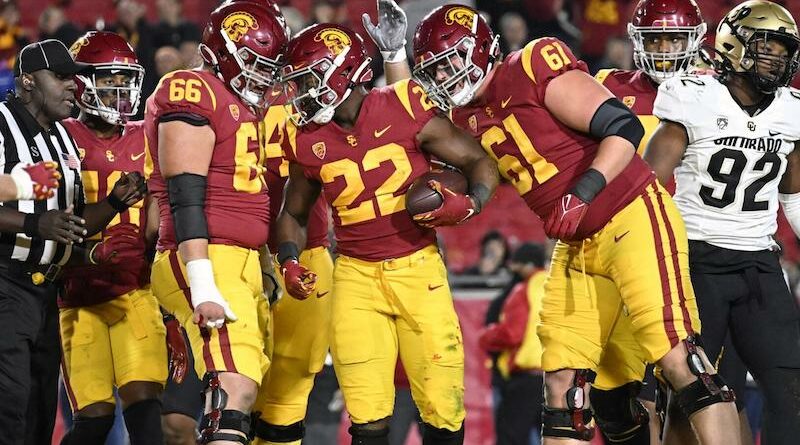
By Stephen Vilardo, SuperWest Sports
November 18, 2022
Moving the ball and getting into the endzone is the name of the game on the offensive side of the ball.
![]() And no matter the level of play, high school, college, or professional, we see teams move down the field and stall out in the Red Zone from time to time.
And no matter the level of play, high school, college, or professional, we see teams move down the field and stall out in the Red Zone from time to time.
The space gets tighter, wideouts have less room to roam and defenses stiffen up. No matter the reason we see it each week, how important the red zone is.
Winning and losing a game can in many cases be traced back to the success and failures of an offense (or defense) in that facet of the game.
 A perfect example of this is the Oregon State at Washington game on November 4. The Beavers had four trips inside the Husky 20 and came away empty-handed on two of them.
A perfect example of this is the Oregon State at Washington game on November 4. The Beavers had four trips inside the Husky 20 and came away empty-handed on two of them.
Washington in turn came away with points in all four of their trips inside the OSU 20. End result UW 24, OSU 21. In that example, Oregon State came up with 0 points on two trips.
A pair of FGs may have won the game (On paper you say it would have…but you can never assume everything plays out as is if OSU kicked two FGs—maybe UW gets a TD and win anyway).
 In Oregon’s game at Washington State, the Ducks had seven trips inside the 20, which translates 42 points available (not assuming a PAT). Oregon came away with three TDs and three FGs on those seven trips.
In Oregon’s game at Washington State, the Ducks had seven trips inside the 20, which translates 42 points available (not assuming a PAT). Oregon came away with three TDs and three FGs on those seven trips.
Essentially, they left 14 points on the field, coming away with 64.3 percent of the Red Zone points available in a game that proved much closer than many anticipated, in which they had to come back to win
As with any stat, we can always dig deeper and find the numbers inside of the numbers. If you look at the total points available you can see just what is left off the board each week.
So using that methodology we will dig a little deeper into Red Zone numbers.
 USC’s conventional red zone rate this season is 86.79 percent, which is tied with Washington for 47th in the nation. It trails Washington State and Arizona State in the Pac-12.
USC’s conventional red zone rate this season is 86.79 percent, which is tied with Washington for 47th in the nation. It trails Washington State and Arizona State in the Pac-12.
If we add in the MWC and BYU the figure ties them for sixth in the region with Wyoming, Air Force, and Nevada all having better marks inside the opposition’s 20.
Looking at full-on red zone success you see that USC has scored 261 of a possible 318 red zone points this season. The Trojans have only left 17.92 percent of possible red zone points on the field.
 That figure is the 13th-best mark in the nation and the best of any team in the region. The team the Trojans were tied with—Washington—is still tied for 46th in the nation with 23.58 percent of points not obtained.
That figure is the 13th-best mark in the nation and the best of any team in the region. The team the Trojans were tied with—Washington—is still tied for 46th in the nation with 23.58 percent of points not obtained.
Washington State, Arizona State, and Air Force all stay in the top 40 but are now below USC. UCLA and Oregon also jump ahead of Washington looking at things from this angle.
The biggest and most drastic drop-off was Wyoming. The Cowboys rank 11th in the nation in Red Zone conversions at 92.31 percent.
On 26 trips Wyoming has come away with 12 TDs, 12 FGs, and just two empty red zone possessions.
But settling for FGs and not punching it in means they have left 30.77 percent of available red zone points off the scoreboard, ranking them 92nd in the nation.
 Among Pac-12 teams, the worst figure belongs to Colorado as the Buffs have left 38.89 percent, 120th among FBS teams.
Among Pac-12 teams, the worst figure belongs to Colorado as the Buffs have left 38.89 percent, 120th among FBS teams.
Colorado State is the worst among teams in our area and in the nation with 66.67 percent of possible red zone points not cashed in.
 The Aztecs have allowed a TD on 18 of 32 attempts and a FG on three with 11 trips coming up empty.
The Aztecs have allowed a TD on 18 of 32 attempts and a FG on three with 11 trips coming up empty.
SDSU is still sold when looking at the rate of points allowed, with a figure of 39.06 percent for the 13th-best mark nationally.
But as far as teams in the area goes, they dip below Oregon State 40.63 (9th) and Boise State 40.91 (7th).
Looking a little closer at the Broncos shows that they are 51st in the nation in traditional red zone rank but eighth in the nation with opponents scoring just 40.91 percent of red zone points available.
 BSU has allowed a TD on just 36.36 percent and allowed a FG on 10 of 22 attempts.
BSU has allowed a TD on just 36.36 percent and allowed a FG on 10 of 22 attempts.
Oregon State’s opponents have gotten just 40.63 percent of their possible red zone points. The Beavers have allowed 78 of a possible 132 red zone points in 2022.
The TD allowed rate is actually curiously high for a team ranked that far up. The Beavers have allowed an opponent to score a TD on 50 percent of their 32 red zone trips.
But the Beavers have allowed a FG on just six trips, so opponents are coming up empty on almost 1/3 of their trips inside the OSU 20.
 Arizona ranks 126th in the nation in keeping points off the board when opponents enter the scoring zone as Wildcat opponents have netted all but 17.02% of available points.
Arizona ranks 126th in the nation in keeping points off the board when opponents enter the scoring zone as Wildcat opponents have netted all but 17.02% of available points.
The TD rate for Arizona opponents is 78.72 percent, the second worst in the nation.
Only Notre Dame has allowed a higher rate of red zone TDs at 80.77 percent, something to remember in a week when the Trojans play the Irish.
Percentage of available points scored (Pac-12 & MWC & BYU)
| National Rank | Team | Percentage |
|---|---|---|
| 13 | USC | 81.67 |
| 17 | WSU | 80.77 |
| 22 | Air Force | 79.69 |
| 27 | Oregon | 78.95 |
| 37 | ASU | 77.63 |
| 38 | Utah | 77.59 |
| 44 | UCLA | 76.42 |
| 44 | Washington | 76.42 |
| 50 | Nevada | 75.86 |
| 62 | Stanford | 74.00 |
| 65 | Cal | 73.53 |
| 68 | OSU | 73.26 |
| 71 | Boise St | 72.92 |
| 72 | UNLV | 72.86 |
| 87 | Arizona | 69.79 |
| 92 | Wyoming | 69.23 |
| 94 | San Jose St | 68.75 |
| 105 | Hawai'i | 66.67 |
| 106 | BYU | 66.22 |
| 109 | Fresno St | 64.89 |
| 116 | SDSU | 62.96 |
| 120 | Colorado | 61.11 |
| 120 | New Mexico | 61.11 |
| 129 | Utah State | 55.36 |
| 131 | Colorado St | 33.33 |
Percentage of available points allowed (Pac-12 & MWC & BYU)
| National Rank | Team | Percentage |
|---|---|---|
| 7 | Boise St | 59.09 |
| 9 | Oregon St | 59.38 |
| 13 | SDSU | 60.94 |
| 17 | Air Force | 61.90 |
| 19 | San Jose St | 62.50 |
| 30 | WSU | 65.71 |
| 34 | Washington | 66.18 |
| 36 | UNLV | 67.39 |
| 39 | Oregon | 67.95 |
| 39 | Wyoming | 67.95 |
| 42 | Nevada | 68.06 |
| 47 | Stanford | 68.42 |
| 48 | Fresno St | 68.75 |
| 56 | USC | 70.24 |
| 81 | BYU | 73.47 |
| 84 | Hawai'i | 74.04 |
| 88 | Cal | 74.36 |
| 100 | Utah | 76.67 |
| 111 | Utah St | 78.95 |
| 112 | Colorado | 79.09 |
| 116 | UCLA | 79.73 |
| 119 | ASU | 80.43 |
| 126 | Arizona | 82.98 |
| 130 | Colorado St | 85.37 |
Follow Stephen on Twitter @StephenVilardo and his organization @SERCenter.
Visit his website at sercstats.com.
-
Ranking the Top Offensive Line Units in the West for 2025
> The region's best groups of guards and tackles for the upcoming college football season - July 14, 2025 -
Ranking the Top Defensive Line Units in the West for 2025
> The best groups of ends, tackles, and nose tackles for the upcoming college football season - July 10, 2025 -
Ranking the Top Linebacker Units in the West for 2025
> The best groups of middle, inside, and outside LBs for the upcoming college football season - July 7, 2025

